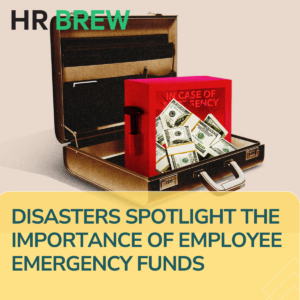Insights from Total Rewards 2025 and the persistent gap between good intentions and real impact.
3 years ago, we witnessed financial wellness at work emerge as a focus at industry trade shows. It was finally getting its due as a key pillar of holistic employee well-being alongside physical, mental, and emotional health. It was a breakthrough moment — business mindsets were shifting, and HR leaders were ready to address the financial stress that had been quietly undermining their workforce for years.
Fast forward to Total Rewards 2025, and the conversations have evolved dramatically. There is a significant focus on AI, pay equity, and other emerging trends. But the thinking around financial wellness has shifted. What we witnessed — and presented on in our session “Bridging the Financial Wellness Gap: Are We Missing What Employees Really Need?” — is that despite widespread adoption, the financial solutions companies have implemented are simply not producing results. And HR and Benefits leaders know it.

Employers Think They’re Helping. Employees Disagree.
The numbers tell a stark story: 49% of employers believe they provide effective financial wellness support, but only 28% of employees agree. That’s a 21-point perception gap, representing a fundamental disconnect between intention and impact.
This gap matters because employees experiencing financial stress — 57% cite it as their number one concern — aren’t finding relief in current programs. The cost is staggering: financially stressed employees spend 3+ hours per week dealing with personal financial matters at work, resulting in a $4.7 billion weekly productivity gap across American businesses.
When $2,000 Derails Everything
To understand why current programs fall short, we need to examine what employees actually face. The data reveals a perfect storm of financial vulnerability:
- 49% of people experience a financial shock each year, with a median cost of those shocks coming in at $2,000;
- However, 59% don’t even have $1,000 to cover unexpected expenses
- Meanwhile, 49% of employees report struggling to pay their basic living expenses, such as housing, food, and utilities, on time each month.
For the majority of Americans living paycheck to paycheck, a burst pipe, car accident, or family emergency creates an impossible choice: pay for the unexpected expense or neglect budgeted necessities. Either option pushes them into financial uncertainty, which follows them to work, where they’re trying to figure out how to make ends meet. Forget about the focus projects and deadlines require.
56% of Your Workforce Feels Left Behind
The most striking revelation from Total Rewards 2025 came from Mercer’s research on hourly workers, who comprise 56% of the American workforce yet often feel like an afterthought in benefits design. Their financial reality* is particularly challenging:
- 72% report increased financial stress
- 51% have reduced discretionary spending
- 37% have reduced their savings

While financial instability can affect employees at any income level — even six-figure earners face financial hardship — the data across Canary’s employer-sponsored emergency relief funds confirms that hourly, lower-wage workers are disproportionately impacted. Traditional financial wellness programs that focus on retirement planning and financial education often overlook the immediate cash flow challenges these employees face.
The Question Everyone’s Asking: What About Fraud?
An interesting dynamic emerged at Total Rewards: fraud prevention was a top concern for leaders considering emergency relief funds as part of their financial wellness at work planning. Multiple attendees directly inquired about fraud detection, reflecting deeper concerns about how a program like this is successfully implemented.
It’s a fair question. When you consider that so many employees are struggling financially, combined with ongoing economic uncertainty, it’s natural to wonder: Will everyone who applies actually qualify for help?
However, this concern often stems from the uncomfortable position traditional approaches put leaders in. Formal or not, almost every workplace does something to help employees facing extreme financial hardship. Maybe it’s promoting a GoFundMe, passing the hat, or approving a pay advance. These situations, like it or not, force HR and Benefits teams to become arbiters of who deserves assistance and who doesn’t. Canary’s independent, third-party review processes, guided by IRS guidelines for financial hardship and conducted by trained grant specialists, remove this burden while maintaining program integrity. In practice, fraudulent requests remain a very small percentage of applications.
Why 9 Out of 10 Employees Still Want to Talk to a Person
One of the most packed sessions at Total Rewards focused on AI implementation, with HR professionals eager to leverage technology for efficiency gains. Yet, Mercer revealed a counterintuitive finding: only one in ten employees prefers AI assistants or chatbots for benefits communication.
This preference for human interaction is particularly pronounced in financial wellness, where employees dealing with crisis situations often require empathy and understanding that can’t be automated. When someone is facing eviction or can’t afford car repairs to get to work, they need a compassionate human voice, not a chatbot response.
It’s Time to Complete the Financial Wellness at Work Puzzle
The conversation around financial wellness at work has matured, but solutions are still catching up. We need to complement existing comprehensive programs with targeted solutions that address the immediate financial crises that traditional offerings don’t cover. Those are the gaps that prevent employees from engaging with traditional offerings in the first place.
Companies like Clear Channel Outdoor, which joined us on stage, have demonstrated a willingness to evolve, expanding from a disaster-only response to a comprehensive program addressing the many urgent, unexpected issues that cause employees to face financial uncertainty. Their experience shows that addressing immediate needs doesn’t replace traditional benefits — it simply helps complete the financial wellness puzzle by ensuring employees can actually benefit from long-term planning tools.
The opportunity is clear for HR and Benefit leaders ready to bridge this gap. Success metrics need to shift from program participation rates to tangible employee outcomes that address the root causes of financial stress. Those who prioritize immediate needs while establishing long-term foundations will reap benefits in both worker well-being and business performance.
Financial wellness programs aren’t inherently failing—they’re simply incomplete. Three years after financial wellness made the main stage, it’s time to evolve and act on our more nuanced understanding of the work ahead of us.

At Canary, we’re proud to partner with forward-thinking employers who recognize the power of emergency relief fund programs. Together, we’ve helped thousands of employees navigate financial crises and regain stability.
Want to learn more? Learn how how our programs are making a difference for other organizations:
Click to download our inaugural Strengthening the Safety Net Annual Report
Click to watch From Breweries to Bogs: How Boston Beer & Ocean Spray Address Employee Financial Stress







